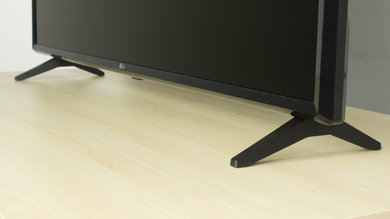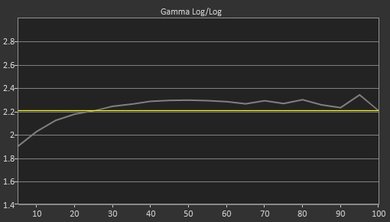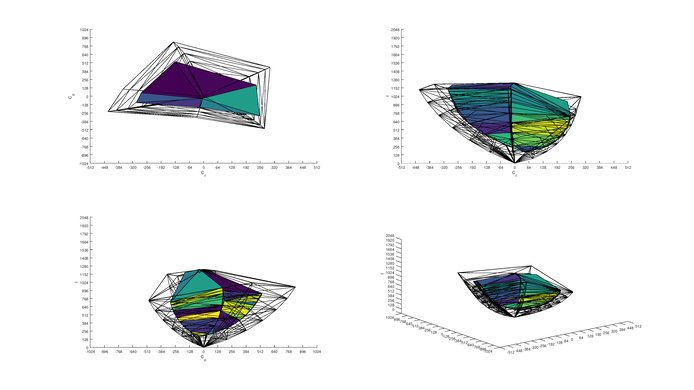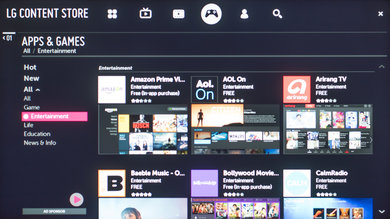Our Verdict
Poor TV for a mixed usage. The LG LJ5500's shortcomings stack up well above its positives, and its below average picture quality greatly reduces its capabilities with every usage.
- WebOS is one of the best smart platforms available.
- Picture quality remains good at an angle.
- 1080p resolution
- Subpar picture quality
Not a good TV for watching movies in dark room. The LJ5500's blacks are shallow and very cloudy making them quite distracting, and its 1080p resolution means it cannot fully take advantage of modern content.
Average TV for watching cable or broadcast television. The LJ5500 gets bright enough for most rooms, and it handles reflections decently. Its WebOS smart features also make it easy to access content. Unfortunately, static content such as network logos are retained for a few minutes, and the overall picture quality is subpar.
The LJ5500 does a decent job with sports broadcasts. Its wide viewing angle means watching it from the sides won't affect the picture quality too much, and it handles fast motion quite well. Unfortunately, its uniformity could be better, and static on-screen content can sometimes be retained for a few minutes.
Passable TV for gaming. The LJ5500 has low motion blur, so fast motion doesn't have any distracting trails. Its input lag is also fairly low, which keeps games responsive and immersive. Unfortunately, the TV's poor overall picture quality reduces the quality of the experience.
The LJ5500 does not support HDR.
The LJ5500 does not support HDR.
Mediocre TV to use as a PC monitor. While it is capable of 4:4:4 chroma and has no major issues with viewing angles, its 1080p resolution is less than ideal for productivity and its input lag could be better. It also lacks niche features like a 120hz input.
Changelog
- Updated Mar 12, 2018: Converted to Test Bench 1.2.
- Updated Sep 11, 2017: Review published.
- Updated Sep 09, 2017: Early access published.
- Updated Sep 06, 2017: Our testers have started testing this product.
Check Price
Differences Between Sizes And Variants
We tested the 43" (43LJ5500). For the most part, we expect our review to be valid for the 49" (49LJ5500) and 55" (55LJ5500).
If someone comes across a different type of panel or if their LG LJ5500 doesn't correspond to our review, let us know and we will update the review. The LG LJ5000 and LG LJ550M are very similar LED TVs but lack the WebOS smart features.
| Size | Model | BestBuy Model |
| 43" | 43LJ5500 | 43LJ550M |
| 49" | 49LJ5500 | 49LJ550M |
| 55" | 55LJ5500 | 55LJ550M |
Popular TV Comparisons

The LG LJ5500 isn't a very good TV, and at its price, there are better options available. If you're capable of stretching your budget a little bit, TVs that perform much better are also available. See our recommendations for the best budget TVs.
The Samsung M5300 is better than the LG LJ5500. The Samsung M5300 has better reflection handling and a wider viewing angle, so it will better suit a wider variety of rooms. The M5300 also has an optional motion interpolation feature which the LJ5500 lacks. This optional feature can clear up motion but introduces some artifacts. The LG LJ5500 is better able to remove judder from 24p sources, which the M5300 can't do.
For those with bright rooms and wide seating arrangements, the LG LJ5500 is a better choice than the TCL S Series/S305 2018 due to its wide viewing angles and higher brightness. However, if you will be sitting right in front and enjoy watching movies in a dark room, then the TCL S305 is a better choice as it has better blacks due to the higher native contrast ratio and better black uniformity.
The TCL S Series/S405 4k 2018 is a much better TV than the LG LJ5500. The TCL has 4K resolution, better contrast, and better black uniformity, which is great if you watch movies in a dark room. The TCL also has better input lag and a faster response time that make it a better choice if you play games. On the other hand, the LG LJ5500 has an IPS panel and thus has better viewing angles.
The TCL 1 Series/D100 is a better choice if you have a dim room and will be sitting right in front. The D100 has a better contrast ratio and a better black uniformity, and thus blacks look deep, and the overall picture quality is improved. On the other hand, if you will be viewing the TV from the side, then the LG LJ5500 is a better choice due to the better viewing angles. The LG LJ5500 is a smart TV and runs LG's WebOS, whereas the TCL D100 has no smart features. To get access to smart features on the D100, you must connect it to an external device or a dongle.

We buy and test dozens of TVs yearly, taking an objective, data-driven approach to deliver results you can trust. Our testing process is complex, with hundreds of individual tests that take over a week to complete. Most of our tests are done with specially designed test patterns that mimic real content, but we also use the same sources you have at home to ensure our results match the real-world experience. We use two main tools for our testing: a Colorimetry Research CR-100 colorimeter and a CR-250 spectroradiometer.
Test Results
The design of the LJ5500 is basic and similar to most other LG TVs is the 6 series such as the UJ6300. It won't stand out in a room but is functional with quite easy to access inputs and has a wide stand that supports the TV well.
The LJ5500 has a simple plastic back. It does look a bit better than most low-mid range TVs due to the molded plastic. Most of the inputs are out the side of the TV and so easy to access if placed close to a wall, but legacy inputs may be difficult to connect when wall mounted.
The LJ5500 has a sub-par native contrast ratio for an LED TV. When compared to other IPS TVs though, with a contrast ratio of 1140, it is in the middle of the pack for this type of panel.
This low contrast ratio means that when set in a dark room, the blacks won't be very black, but will look more like gray than really black. Fortunately, this is less noticeable when the TV is set in a room with a good lighting since the room ambiant light will render less noticeable this low contrast ratio.
The LJ5500 does not have a local dimming feature. The video is for reference only.
Decent SDR peak brightness, good enough for a moderately lit room but may appear too dim in a bright room. The brightness remains consistent no matter the content shown, which is good.
HDR is not supported.
The LJ5500 overall gray uniformity is average. Looking at our 50% gray uniformity picture, the main thing that catches the eyes is the 2 brighter spots in the top left part of the screen. The corners and sides are also a bit darker than the rest of the screen and the bottom part is a bit warmer than the top. Dirty screen effect is visible, unfortunately, especially while watching sports like hockey of soccer.
The uniformity in the darker shade of gray is much better than the 5 percent though, and not much can be noticed at all on that aspect.
The LJ5500's black uniformity is bad. Some flashlighting is visible near both top corners. Some clouding was also visible here and there with some darker patches near the lower corners. Overall, the screen is not very uniform and this will be particularly visible in dark scenes in movies or TV shows.
The reflection handling of the LJ5500 is quite good. It has a semi-gloss finish which diffuses direct reflections across the screen, reducing their intensity. It is fine for an average room, but in a bright room, reflections may be an issue.
Out of the box, when the LG LJ5500 is set to the 'Expert (Dark room)' picture setting, and with the 'Warm2' color temperature, the overall accuracy is below average. If the TV is set to another picture mode or one of the other color temperature, then the accuracy is even more disappointing.
The white balance is a bit on the warmer side, but just slightly, and the dE is higher than what we would like (4.16), as an avid enthusiast could notice there is something a bit off here. The gamma is not too bad though since even if the curve is not flat, we still end up with 2.22, which is not too far from our target. The only small issue with the gamma is in the lower stimulus level, where the TV might loose some contrast in the very dark region, but besides that, it looks good.
The color accuracy is also a bit high with a dE of 3.91. Most of the issues here derive from the fact that the white point is a bit off and thus, all the other colors follow. Only the yellow and blue are a bit more off target than the rest.
After calibration, the LJ5500 shows excellent accuracy. Both the white balance dE and color dE are much more precise and accurate. There is only a small imperfection in the lower stimulus, but this did cause a problem and we could not fix it without causing more trouble.
The only downside here is that the whole process was pretty inconsistent, as the 2 point, 20 points white balance and color space management were not very accurate and responsive. In the 20 points white balance control, each point was affecting up to 2 or 3 points higher, make the whole process a bit longer. This was a bit of a surprise, as much of the 2017 LG line up that we did calibrate had very responsive and precise control over the white balance.
In the end, the calibration was still a plus and the result was good, but it only took a bit more time to do than usual.
You can see our recommended settings here.
Standard color gamut, but good enough for SDR content using the Rec 709 color space.
Poor color volume. The TV's standard color gamut and low contrast ratio prevent it from showing a lot of colors at a range of brightness levels.
The LG LJ5500 performs excellent on our gradient test. Almost no banding at all can be seen on our test picture, besides some little irregularities in the dark green. No 8-bit banding can be seen at all. This is one of the best gradients with have tested yet in 2017.
The LG LJ5500 IPS TV does present some image retention. After the 10 minutes burn-in scene, as we can see on our test picture, the image retention is easily noticeable, but after 2 minutes of recovery, the retention is already very faint and almost non-noticeable.
Even if this result is disappointing, overall, when you compare to other TV, VA panel TVs especially, the fact that the retention clears up pretty fast is good news and when compared to other IPS TVs tested before, the LJ5500 would be in the middle of the group performance wise.
Although some IPS panels can suffer from temporary image retention, this doesn't appear to be permanent as seen in our long-term test.
The LG LJ5500 uses PWM at 120Hz to dim the backlight, starting at 100/100 backlight setting. Lowering the setting shortens the duty cycle, while amplitude remains constant. Backlight PWM helps clear up motion slightly, but results in duplicate images following fast-moving objects, visible in the motion blur picture.
The LJ5500 has no optional BFI setting to reduce its flicker frequency to 60 Hz, though its 120 Hz PWM backlight does help somewhat to make motion more clear.
The LJ5500 has no motion interpolation features, so fans of the soap opera effect may be disappointed.
The LJ5500 is great at displaying movies and sports without any stutter. The LCD response time helps to blur the transition between frames, producing smooth movement even for movies.
The LJ5500 can display without judder 24p movies only from 24 sources and this when the 'Real Cinema' option (from the 'Picture Option' menu). 24p movies playing from 60p/60i sources do present some judder, and unfortunately, there is no way to remove it.
The LG LJ5500 has a 60Hz panel without support for more advanced features such as FreeSync.
Great low input lag, which should please all but the most competitive gamers. The 'Game' picture mode has the lowest input lag, even in PC mode. PC mode on most other LG TVs has low input lag for all picture modes, but this is not the case with this TV, as only the Game picture mode has low input lag.
Because this TV only has a 1080p @ 60 Hz panel, many common resolutions aren't supported. 4:4:4 color is only shown properly when the input's icon is set to PC (aka 'PC mode').
Disappointing frequency response. While the LJ5500 follows the target very well, its limited low-frequency extension makes it sound quite thin. It also has a fair amount of dynamic range compression at higher volumes, and it doesn't get very loud at all.
Good distortion performance. While there is a rise in IMD at higher volumes, the levels are low throughout. THD also remains low at max volume which is unusual.
LG's webOS interface is split into three sections: settings, inputs, and apps. Each section has its own button on the remote, a quick menu, and a full menu containing advanced options. This shortens the number of steps needed to find what you're looking for, but the separated nature may be confusing for first-time users.
Many popular apps come pre-installed on the TV, such as Netflix, YouTube and Amazon Video. The LG Content Store has a lot of apps available for download, but not quite as many as on Samsung or Android TVs.
This TV comes with the basic LG remote, which is mid-size and light despite offering a lot of buttons. Unfortunately, the rubber chunk buttons aren't as easy to press as the remotes of most other TVs. Most commonly used buttons are within easy reach of the direction pad which is good, but unfortunately the inputs button is in the top right hand corner and is hard to reach with one hand.
The LG remote app has some useful features, such as streaming files off the device running the app, but is missing some other features like text entry.










































